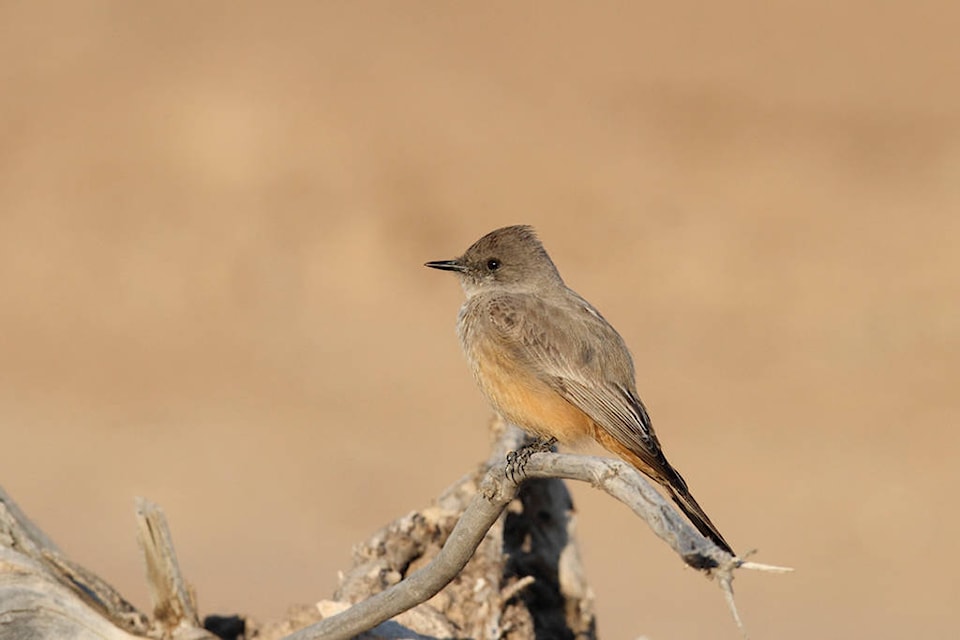I feel sad. I’ve made some decisions lately that may have unsettled a pair of Say’s Phoebes. After removing their last year’s nest I discovered they often return to the same nest!
Somewhat smaller than a robin with a soft warm gray back, slightly darker head and low crest, a long dark tail and light pinkish-orange breast, they are attractive little birds. A member of the flycatcher family, Phoebes catch flies and crickets, beetles, grasshoppers, flies, moths, mosquitoes and wild bees, usually snatched on the wing.
We’re fortunate to have these pest controllers. They’re great friends to our agricultural industry and my neighbourhood too.
Alas, I might not be the best kind of friend in return.
I’ve been watching Phoebes since I arrived in the Okanagan six years ago. Like me, they prefer dry, open landscapes. Last spring I decided to get more involved in their lives. I decorated low bushes and stumps around my place with lots of twine, embroidery thread and narrow ribbons.
When they started nest building, a lot of my brightly colour contributions were woven into the grass and straw base. It was easy to see what they were up to as they’d chosen their nest site on a carport emergency light.
Then I read that providing twine, string, thread, ribbon and wool can have unfortunate results. These household items don’t break or break down like natural stems, grasses and such and can trap the birds, especially the young who may not be strong enough to escape.
Of course, by this time nothing could be done, but I did get a chance to redeem myself a little bit. The nest had begun to slip off the smooth surface of the carport light. Anxious to do the right thing, I asked a wiser nature lover whether I could make some structural changes.
“Don’t worry,” my friend said. “Birds have a high degree of nest fidelity and won’t be disturbed by your work. They’ll be back as soon as you’re out of the way.”
Excellent information! I added a band of fabric around the base of the nest and tacked it to a beam above.
I also encouraged a very enthusiastic gopher snake to pursue a meal elsewhere. My nature credit account had a noticeable uptick!
Within a few weeks, two bare-naked little Phoebes wobbled from a likely clutch of four white eggs and kept their parents busy bringing insect meals. Another couple of weeks later the hatchlings were flying and roosting with their parents in the carport.
The family made a real dent in the insect population!
Once the Say’s Phoebes had headed south for the winter to Southern California or the coasts of Northern Mexico, I decided to take down the nest, clean the light, change the battery, and generally do some carport housekeeping.
This spring when I heard the plaintive one, sometimes two-note slurred whistle or a breathy “ssstwhew” I knew they had returned. Though I don’t know if this is the same pair, the female and a new mate or vice-versa, but Phoebes are known to return to the same locations year after year, often in pairs.
In my wisdom, I thought they might be happier with a little wooden platform instead of the light fixture. Apparently, they will nest on a platform made to the proper specifications and frequently choose domestic settings. But after they’d been around for a week or so I hadn’t seen any activity.
I’ve also read that some birds are disoriented by flat surfaces. The platform didn’t offer the dips and odd shape of the light fixture. Down with the platform, up with the light, but no Phoebe nest as yet.
They’re probably waiting until the insect supply is assured, or I’m out of the way!
I’ve seen them flying regularly to and from an old barn building nearby. I’ll have to check if they’ve settled in there, no thanks to me.
Dianne Bersea is a member of the South Okanagan Naturalists. Views expressed do not necessarily represent SONC. Info on birding events visit: southokanagannature.com/birding/
